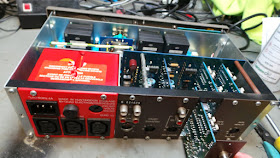The 44 is a very interesting pre-amp. It's got a lovely design of tone control. Quad went their own way with adding tone controls, and made theirs with 3 tone filters and an adjustable slope control.
The look of the thing is even unique.
 The pre-amp has a flexible card system. Each input is selected by a CD4066 switch, which connects the selected card. This unit has the standard line-up of "Radio", "Disc" for a Moving magnet cartridge (an MC card is/was available), a CD/AUX card and two tape loops. Excellent.
The pre-amp has a flexible card system. Each input is selected by a CD4066 switch, which connects the selected card. This unit has the standard line-up of "Radio", "Disc" for a Moving magnet cartridge (an MC card is/was available), a CD/AUX card and two tape loops. Excellent. Not only that, but the Disc card allows differing gains to be selected to accommodate for most carts, and switchable capacitance load too. The tape loops are similarly configurable for level and impedance. Nice....
Not only that, but the Disc card allows differing gains to be selected to accommodate for most carts, and switchable capacitance load too. The tape loops are similarly configurable for level and impedance. Nice.... This later "MKII" model has a re-designed main board and ALPS pots....
This later "MKII" model has a re-designed main board and ALPS pots....Issues....
CD4066? Known for introducing distortion into the signal path. Thankfully Maxim produce the MAX4066. A much better specified, and pin for pin compatible device....
So, before I start, let's make a baseline measurement of THD (Total harmonic distortion) at 1KHz.... 0.059% on the CD/AUX channel.
Not too shabby....

Out with the old, and in with the new....
All 4 ICs are changed.
Whilst I'm in there I evict the Red electrolytics, as they're know to fail, although these all read OK.
Let's have a look at the disc card...
 It consists of TL071 op-amps.... which are mediocre. I'll swap them out for some better NE5534, which should lower noise a bit, as well as distortion. These are the better NE5534's with 18V/uS slew rate.
It consists of TL071 op-amps.... which are mediocre. I'll swap them out for some better NE5534, which should lower noise a bit, as well as distortion. These are the better NE5534's with 18V/uS slew rate. ... and here is the main issue for me....
... and here is the main issue for me....The CD/Aux card....
300mV? ... 300mV!!!!
Since when?
Most CD players put out at least a volt...
All this means practically, is we'll need to turn our volume control down everytime we switch to CD. An inconvenience. We *may* overload the input.
I've seen some CD players output as much as 2V, so 300mV is not going to cut it....
It's also originally fitted with a TL072, which I'll change for an NE5532..
I do some googling, and there's various recommendations about changing the resistors in the feedback loop of the card to reduce the gain to unity... but none of the modifications seem to relate to the input card I have fitted, an M12815:1. I don't have a schematic, so I sketch one out....

... well, it's already a unity-gain amplifier!
So, what to do? I could trace the signal through and change the gain on the main board, but that will leave me with the same discrepancy when switching between CD and disc or radio.... Nothing for it but to add a bit of attenuation in.

Simply adding a 180 ohm resistor across the existing 820 ohm resistor will divide the voltage down to a more respectable level.
 ... and it's easy to implement...
... and it's easy to implement...Don't forget to do both channels.
 So after all out mods... how does it measure?
So after all out mods... how does it measure?... The THD has dropped to 0.014%....
How does it sound? Noticeably quieter (noise-wise!), but to my cloth ears, I can't really tell much difference in the distortion.
Right, now to the 405-2 Power amp!
Watch this space....






